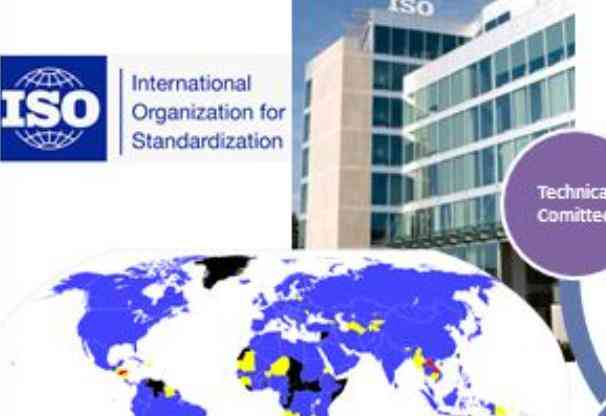|
Ref. No.: IS0 / R 587 - 1967 (E)
IS0
I NT ERN AT 10 NA L O RG A N IZAT I ON FOR STA N D A R D I Z AT I O N
IS0 R E CO M MEN DATI O N
R 587
DETERMINATION OF CHLORINE IN COAL AND COKE
USING ESCHKA MIXTURE
1st EDITION
July 1967
COPYRIGHT RESERVED
The copyright of IS0 Recommendations and IS0 Standards
belongs to IS0 Member Bodies. Reproduction of these
documents, in any country, may be authorized therefore only
by the ~tiOnal standards organization of that country, being
a member of ISO.
For each individual country the only valid standard is the national standard of that country.
Printed in Switzerland
Also issued in French and Russian. Copies to be obtained through the national standards organizations.
---------------------- Page: 1 ----------------------
BRIEF HISTORY
The IS0 Recommendation R 587, Determination of Chlorine in Coal and Coke using
Eschka Mixture, was drawn up by Technical Committee ISO/TC 27, Solid Mineral Fuels,
the Secretariat of which is held by the British Standards Institution (BSI).
Work on this question by the Technical Committee began in 1951 and led, in 1961,
to the adoption of a Draft IS0 Recommendation.
In March 1964, this Draft IS0 Recommendation (No. 677) was circulated to all the
IS0 Member Bodies for enquiry. It was approved, subject to a few modifications of an
editorial nature, by the following Member Bodies :
Germany Romania
Australia
Austria India Switzerland
Belgium Italy Turkey
Japan U.A.R.
Brazil
Canada Korea, Rep. of United Kingdom
Chile Netherlands U.S.A.
Colombia New Zealand U.S.S.R.
Czechoslovakia Poland
Denmark Republic
France of South Africa
No Member Body opposed the approval of the Draft.
The Draft IS0 Recommendation was then submitted by correspondence to the IS0
Council, which decided, in July 1967, to accept it as an IS0 RECOMMENDATION.
-3-
---------------------- Page: 2 ----------------------
IS0 / R 587 - 1967 (E)
IS0 Recommendation R 587 July 1967
DETERMINATION OF CHLORINE IN COAL AND COKE
USING ESCHKA MIXTURE
1. SCOPE
This IS0 Recommendation describes a method of determining the amount of chlorine in hard
coals, cokes, brown coals and lignites, using Eschka mixture. Alternative methods, involving
combustion in a calorimetric bomb or at high temperature, are described in separate IS0 Recom-
mendations.*
2. PRINCIPLE
The sample is ignited in intimate contact with Eschka mixture in an oxidizing atmosphere to
remove combustible matter and to convert the chlorine to alkali chlorides. These are extracted
with nitric acid or water and determined by titration by either the Volhard or the Mohr procedure.
3. REAGENTS
All reagents should be of analytical reagent quality and distilled water should be used throughout.
3.1 Eschka mixture. Mix two parts by mass of light calcined magnesium oxide with one part of
anhydrous sodium (or potassium) carbonate. The mixture should entirely pass a test sieve
of 0.2 mm aperture.
3.2 Nitric acid, chlorine-free, relative density d = 1 42.
Volhard titration
3.3 Nitrobenzene. Store in a dark glass bottle.
3.4 Silver nitrate solution 0.025 N. Heat crushed crystalline silver nitrate at 125 "C for 2 to
3 hours. Dissolve 4.247 g in water and dilute to 1000 ml. Store in a bottle of amber glass.
3.5 Potassium thiocyanate solution. Dissolve 3.5 g of potassium thiocyanate in water and dilute
to 1000 ml. Standardize by titration against the silver nitrate solution (3.4) and adjust to
exact equivalence.
3.6 Saturated solution of femc alum (ammonium femc sulphate) indicator. Saturate 100 ml of
water with ferric alum [(NHJ2S0,. Fe2(S0J,. 24H,O, approximately 125 g] and add suffi-
cient nitric acid (3.2) to remove the brown colour.
Mohr titration
3.7 Silver nitrate solution 0.050 N. Weigh 8.494 g of silver nitrate, dried as in clause 3.4, dissolve
in water and dilute to 1000 ml.
3.8 Potassium chromate indicator solution. Dissolve 5 g of potassium chromate in 100 ml of water.
* See IS0 Recommendations R 350, Determination of ChIorine in Coal by the Bomb-combustion Method,
R 352, Determination of Chlorine in Coal by the High Temperature Combustion Method.
-5-
---------------------- Page: 3 ----------------------
IS0 / R 587 - 1967 (E)
4. APPARATUS
All graduated apparatus should be of the best analytical quality obtainable.
4.1 An electrically heated muffle furnace, with a zone of substantially uniform temperature at
675 f 25 "C and a ventilation rate of 4 to 6 air changes per minute (see Note below).
4.2 Crucibles, of porcelain or silica, of approximately 25 ml capacity.
4.3 Insulating plate, 6 mm thick, of silica or other suitable material, which fits easily in the muffle.
4.4 Balance, sensitive to 0.1 mg.
NorE.-The necessary rate of air change can be obtained by using a suitably designed muffle furnace and
may be checked by means of a pitot-static tube.
5. PROCEDURE
5.1 Decomposition of test portion. Before commencing the determination, mix the air-dried
sample, ground to pass a sieve of 0.2 mm aperture, thoroughly for at least one minute,
preferably by mechanical means.
Weigh accurately a test portion of about 1 g (see Note 1, page 7) in a scoop and transfer it
to a crucible containing 3 g of the Eschka mixture (3.1). Mix intimately, using a small metal
spatula, and cover with a further 2 g of the Eschka mixture (3.1).
Place the crucible on the insulating plate, insert both into the muffle at 675 f 25 "C (se
...














